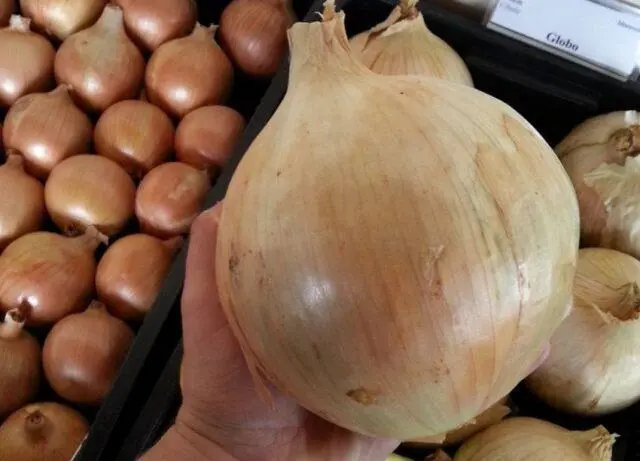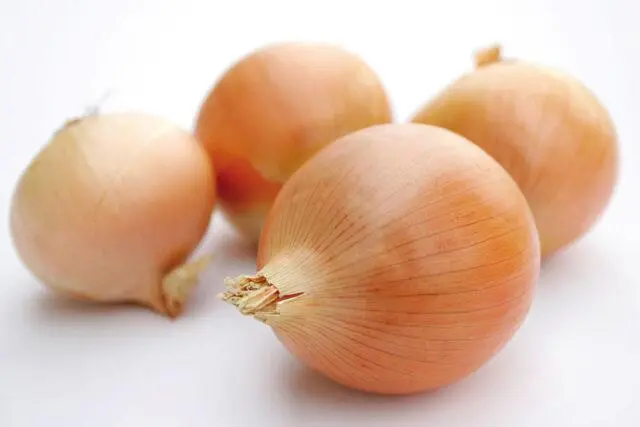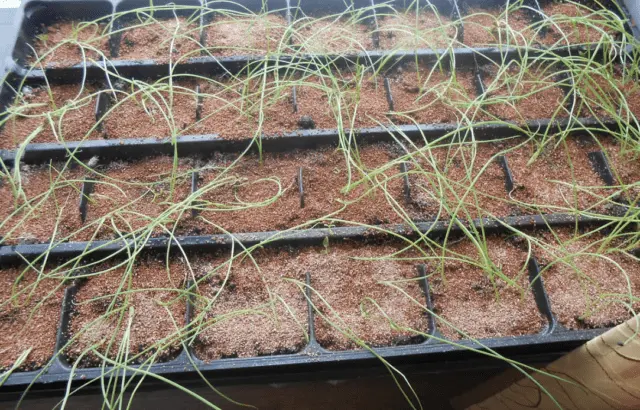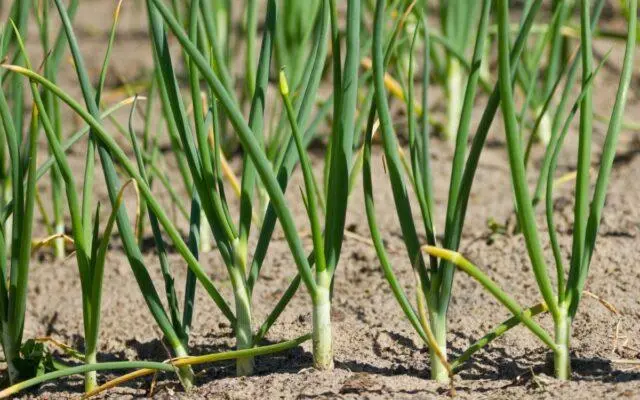Contents
Onion Globo is a Czech large-fruited variety with a mild taste. Characterized by high productivity. Root crops ripen only by September (late-ripening). Almost all bulbs are large, regular rounded shape. You can grow both for yourself and for sale.
History of origin
Luk Globo was bred in the Czech Republic by employees of the Semo company (founded in 1994). The variety quickly spread in different countries of Europe, came to Our Country. It is not included in the register of breeding achievements of the Federation, although it is known to many summer residents.
Description and characteristics of onion variety Globo
Onion Globo belongs to large-fruited varieties – the bulbs are massive, attractive in appearance and very tasty. Due to the high yield, the crop can be cultivated both for personal consumption and for sale.
Appearance
Bulbs Globo classic round shape. The husk is golden in color. The sizes are large, the average weight is 400–500 g, often reaches 700–900 g. Some bulbs can be slightly elongated, elliptical in shape.
Ripening time and yield
Onion Globo refers to late-ripening varieties. It matures within 120–160 days after germination. The timing depends on the climatic conditions of the region and agricultural technology. When planted in spring, the crop can be harvested in September. To accelerate maturation, a seedling method of cultivation is used. The crop yield is very high – the indicator reaches 12–14 kg per 1 m2, i.e. 120–140 kg per hundred.
Disease and pest resistance
Onion Globo has excellent resistance to diseases and pests – this ensures high yields. However, the risk of damage cannot be completely ruled out. For example, with improper care, as well as in cold and rainy summers, the culture may suffer from peronosporosis (downy mildew). The invasion of onion flies and other pests is not ruled out. Therefore, periodically landings need to be inspected. At the first signs of the disease, they are treated with folk remedies or special preparations.

Onion Globo gives very large root crops weighing up to 700 g
Composition and Properties
The inner layers of a light shade, white on the cut. The onion is juicy, the taste is sweetish, not spicy, many summer residents are rated as excellent. The composition of the onion includes vitamins, sugars, trace elements and other valuable components:
- vitamins of group B, C, E, PP;
- saponins;
- glycosides;
- phytoncides;
- essential oils;
- pectins;
- organic acids;
- macro- and microelements (potassium, sulfur, iron, phosphorus, iodine and others).
Application
Globo onion has a mild taste, so it is especially good fresh. Used to prepare salads, all kinds of dishes. Suitable for homemade preparations – pickles, marinated dishes.
Growing regions
Onion normally adapts to different climatic conditions, so it is grown in almost all regions of the country from the middle zone and the North-West to the Urals, Siberia and the Far East. Luk Globo is unpretentious in care. He is not afraid of short-term frosts, although when the temperature drops to -5 degrees, the seeds and seedlings die.
Advantages and disadvantages
Globo onions are primarily valued for a good harvest, large root crops and excellent taste. Culture has other advantages as well.

Bulbs Globo have an attractive presentation
Pros:
- mild taste;
- high yield;
- large bulbs (can be considered as a minus);
- resistance to many diseases, pests;
- good keeping quality and transportability;
- standard care requirements;
- can be grown in most regions.
Cons:
- resistant to return frosts;
- late ripening – harvest in September;
- may suffer from peronosporosis, insects.
When to plant Globo onions
Onion Globo belongs to late varieties, so they try to plant it early. The culture will not withstand return frosts below zero, so the period must be selected carefully, taking into account the method of cultivation and the climatic conditions of the region:
- If used for seedlings, then the seeds are planted in March.
- Seedlings are transferred to open ground in early May.
- Also, seeds can be sown immediately in the garden. The optimal time is from mid-April to early May.
- If you plant sevok, planting is planned for the first half or mid-May.
Methods for planting Globo onions
Onion Globo is most often grown from seed. They can be planted in seedlings, which is especially important for regions with a short summer (Urals, Siberia, the Far East). In the south, seeds can be planted immediately in open ground and harvested in September. Another way is planting sevka (better at the end of May). This is a universal option that is suitable for all regions.
Sowing onion Globo for seedlings
It will take more effort to grow Globo onion seedlings, but a high yield is guaranteed, and the likelihood that the plants will suffer from frost is practically excluded. Before planting, the seeds must be prepared:
- hold for 30 minutes in a 1% solution of potassium permanganate;
- put in warm water for several hours.
- let dry;
- soak in a growth stimulant, for example, in “Epin”;
- put on wet gauze and stand for a week (preferably in a saucer).
Seeds are planted in boxes 10–12 cm high. The soil must be fertile, for example, garden soil with humus, black peat and sand (2:1:1:1). Before planting, several grooves are formed 1 cm deep at a distance of 5 cm. Seeds are planted at 3 cm intervals, sprinkled a little with soil and sprayed with water from a spray bottle.

Globo onion seedlings are conveniently grown in cassettes
Cover the container with a film and put in a warm place (23–25 degrees). After the emergence of seedlings, the shelter is removed and grown at 16-18 degrees. In two weeks, they begin to harden the seedlings – they take them out to the balcony for several hours, gradually increasing the time. They are planted in the ground according to the following scheme:
- depth – 2 cm;
- distance between seedlings – 10 cm;
- distance between rows – 50 cm.
Growing onion Globo from seeds in the open field
Seeds in open ground are sown according to the same scheme. Previously, the bed is cleaned, dug up, fertilized. The soil should be light and fertile, such as loam or sandstone. If the soil is depleted, it is pre-fertilized with organic matter (compost, humus) at the rate of one bucket per 2 m2. The first step is to keep the soil moist. Until shoots appear, it is recommended to cover with a film at night and on cold days.
Planting sevka in the spring
For planting Globo onion sets, open areas are chosen without flooding and stagnant moisture (lowlands are excluded). Planting material is prepared in two weeks. It is heated at a temperature of 45 degrees for eight hours, then pickled in a fungicide solution for 30–40 minutes and left to dry at room temperature.
The landing pattern is as follows:
- furrows 2 cm deep;
- the interval between sets is 8–10 cm;
- distance between rows 30–40 cm.
Globo onion care
Onion Globo is undemanding to care, but to get a good harvest, you should pay attention to it. It is especially important to do the following:
- Watering – at the first stages plentiful, then as the soil dries out. In the heat (in the evening), the greenery needs additional irrigation.
- Fertilizers should be applied only during the period of active growth of feathers. Organics are best suited – mullein, infusion of cut grass. Further top dressing is not necessary.
- Loosening and weeding – as needed.

To prevent the withering of greenery, it must be irrigated in a drought.
Fighting diseases and pests
Onion Globo rarely suffers from diseases or pests. If brown spots or purple bloom appear on the leaves, and the feathers become lethargic, it is necessary to treat with fungicides as soon as possible:
- Bordeaux liquid;
- “RAW”;
- “Maksim”;
- “Order”;
- “Fitosporin”.
With the invasion of onion flies, moths, thrips and other pests, Globo onion plantings are sprayed with home solutions (for example, tobacco dust, wood ash, laundry soap, baking soda, chili peppers). In extreme cases, insecticides are used:
- “Aktara”;
- “Decis”;
- “Confidor”;
- “Inta-Vir”;
- “Match”.
Conclusion
Luk Globo, despite its foreign origin, is well adapted to climatic conditions. The culture is grown in seedlings. In the south, seeds can be planted immediately in open ground. Agricultural technology is simple, so even a novice summer resident can handle the cultivation.









